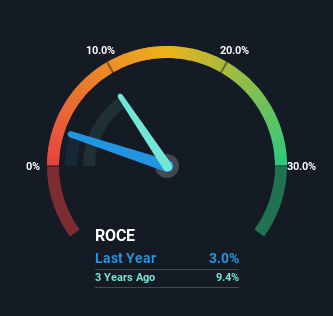Capital Allocation Trends At Sah Polymers (NSE:SAH) Aren't Ideal
What are the early trends we should look for to identify a stock that could multiply in value over the long term? One common approach is to try and find a company with returns on capital employed (ROCE) that are increasing, in conjunction with a growing amount of capital employed. If you see this, it typically means it's a company with a great business model and plenty of profitable reinvestment opportunities. Although, when we looked at Sah Polymers (NSE:SAH), it didn't seem to tick all of these boxes.
What Is Return On Capital Employed (ROCE)?
Just to clarify if you're unsure, ROCE is a metric for evaluating how much pre-tax income (in percentage terms) a company earns on the capital invested in its business. To calculate this metric for Sah Polymers, this is the formula:
Return on Capital Employed = Earnings Before Interest and Tax (EBIT) ÷ (Total Assets - Current Liabilities)
0.03 = ₹29m ÷ (₹1.4b - ₹392m) (Based on the trailing twelve months to December 2023).
Thus, Sah Polymers has an ROCE of 3.0%. Ultimately, that's a low return and it under-performs the Packaging industry average of 13%.
Check out our latest analysis for Sah Polymers

While the past is not representative of the future, it can be helpful to know how a company has performed historically, which is why we have this chart above. If you'd like to look at how Sah Polymers has performed in the past in other metrics, you can view this free graph of Sah Polymers' past earnings, revenue and cash flow.
The Trend Of ROCE
On the surface, the trend of ROCE at Sah Polymers doesn't inspire confidence. Over the last four years, returns on capital have decreased to 3.0% from 6.0% four years ago. Although, given both revenue and the amount of assets employed in the business have increased, it could suggest the company is investing in growth, and the extra capital has led to a short-term reduction in ROCE. If these investments prove successful, this can bode very well for long term stock performance.
On a related note, Sah Polymers has decreased its current liabilities to 29% of total assets. That could partly explain why the ROCE has dropped. Effectively this means their suppliers or short-term creditors are funding less of the business, which reduces some elements of risk. Some would claim this reduces the business' efficiency at generating ROCE since it is now funding more of the operations with its own money.
What We Can Learn From Sah Polymers' ROCE
While returns have fallen for Sah Polymers in recent times, we're encouraged to see that sales are growing and that the business is reinvesting in its operations. And the stock has followed suit returning a meaningful 57% to shareholders over the last year. So should these growth trends continue, we'd be optimistic on the stock going forward.
One more thing, we've spotted 4 warning signs facing Sah Polymers that you might find interesting.
While Sah Polymers may not currently earn the highest returns, we've compiled a list of companies that currently earn more than 25% return on equity. Check out this free list here.
New: Manage All Your Stock Portfolios in One Place
We've created the ultimate portfolio companion for stock investors, and it's free.
• Connect an unlimited number of Portfolios and see your total in one currency
• Be alerted to new Warning Signs or Risks via email or mobile
• Track the Fair Value of your stocks
Have feedback on this article? Concerned about the content? Get in touch with us directly. Alternatively, email editorial-team (at) simplywallst.com.
This article by Simply Wall St is general in nature. We provide commentary based on historical data and analyst forecasts only using an unbiased methodology and our articles are not intended to be financial advice. It does not constitute a recommendation to buy or sell any stock, and does not take account of your objectives, or your financial situation. We aim to bring you long-term focused analysis driven by fundamental data. Note that our analysis may not factor in the latest price-sensitive company announcements or qualitative material. Simply Wall St has no position in any stocks mentioned.
About NSEI:AERONEU
Aeroflex Neu
Manufactures and sells packaging solutions in India and internationally.
Excellent balance sheet with proven track record.
Similar Companies
Market Insights
Community Narratives




